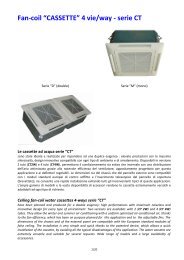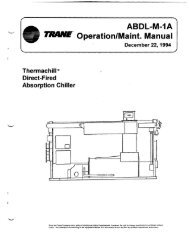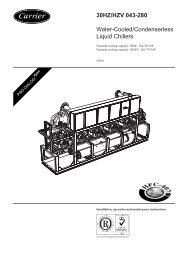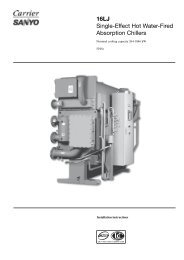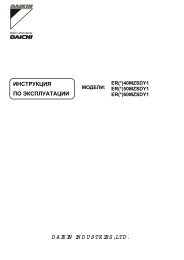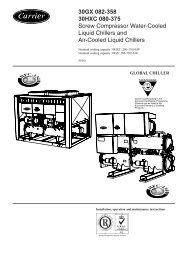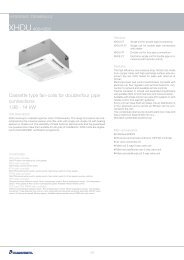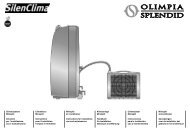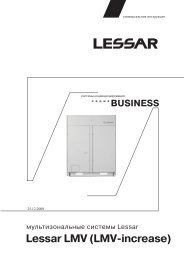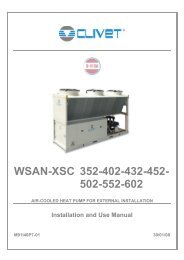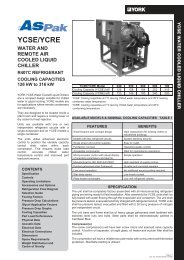"A" Ductable Liquid Chillers with Integrated Hydronic Module
"A" Ductable Liquid Chillers with Integrated Hydronic Module
"A" Ductable Liquid Chillers with Integrated Hydronic Module
Create successful ePaper yourself
Turn your PDF publications into a flip-book with our unique Google optimized e-Paper software.
12.4 - Refrigerant guidelinesRefrigeration installations must be inspected and maintainedregularly and rigorously by specialists. Their activities must beoverseen and checked by properly trained people. To minimisedischarge to the atmosphere, refrigerants and lubricating oilmust be transferred using methods which reduce leaks andlosses to a minimum and <strong>with</strong> materials that are suitable for theproducts.• Leaks must be repaired immediately.• All units are equipped <strong>with</strong> two special connections on thesuction and liquid line, which permit the connection ofquick-connect recovery valves <strong>with</strong>out loss of refrigerant.• If the residual pressure is too low to make the transferalone, a purpose-built refrigerant recovery unit must beused.• Compressor lubricating oil contains refrigerant. Any oildrained from a system during maintenance must thereforebe handled and stored accordingly.• Refrigerant under pressure must never be discharged tothe atmosphere.• If the refrigerant circuit is opened, plug all openings if theoperation takes up to one day, or charge the circuit <strong>with</strong>nitrogen for longer operations.12.5 - Recharging liquid refrigerantCAUTION: 30RY units are charged <strong>with</strong> liquid HFC-407Crefrigerant.This non-azeotropic refrigerant blend consists of 23% R-32,25% of R-125 and 52% R-134a, and is characterised by thefact that at the time of the change in state the temperature ofthe liquid/vapour mixture is not constant, as <strong>with</strong> azeotropicrefrigerants. All checks must be pressure tests, and theappropriate pressure/temperature ratio table must be used todetermine the corresponding saturated temperatures(saturated bubble point curve or saturated dew point curve).Leak detection is especially important for units charged <strong>with</strong>refrigerant R-407C. Depending on whether the leak occurs inthe liquid or in the vapour phase, the proportion of thedifferent components in the remaining liquid is not the same.NOTE: Regularly carry out leak checks and immediatelyrepair any leak found.12.6 - UnderchargeIf there is not enough refrigerant in the system, this is indicatedby gas bubbles in the moisture sight glass.If the undercharge is significant, large bubbles appear in themoisture sight glass, and the suction pressure drops. Thecompressor suction superheat is also high. The machine mustbe recharged after the leak has been repaired.Find the leak and completely drain the system <strong>with</strong> a refrigerantrecovery unit. Carry out the repair, leak test and then rechargethe system.IMPORTANT: After the leak has been repaired, the circuitmust be tested, <strong>with</strong>out exceeding the maximum low-sideoperating pressure shown on the unit name plate.The refrigerant must always be recharged in the liquid phaseinto the liquid line.The refrigerant cylinder must always contain at least 10% of itsinitial charge.For the refrigerant quantity per circuit, refer to the data on theunit name plate.12.7 - Characteristics of R407CSee the table following.Saturated bubble point temperatures (bubble point curve)Saturated dew point temperatures (dew point curve)12.8 - Electrical maintenanceWhen working on the unit comply <strong>with</strong> all safety precautionsdescribed in section “Maintenance safety considerations”.- It is strongly recommended to change the fuses in theunits every 15000 operating hours or every 3 years.- It is recommended to verify that all electrical connectionsare tight:a. after the unit has been received at the moment ofinstallation and before the first start-up,b. one month after the first start-up,when the electricalcomponents have reached their nominal operatingtemperatures,c. then regularly once a year.If there is a leak in the plate heat exchanger, this part mustbe replaced.25



